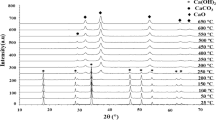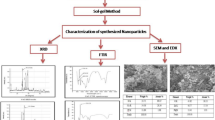Abstract
The fast dissolution of certain calcium-containing compounds makes them attractive carriers for trace minerals in nutritional applications, e.g., iron and zinc to alleviate mineral deficiencies in affected people. Here, CaO-based nanostructured mixed oxides containing nutritionally relevant amounts of Fe, Zn, Cu, and Mn were produced by one-step flame spray pyrolysis. The compounds were characterized by nitrogen adsorption, x-ray diffraction, (scanning) transmission electron microscopy, and thermogravimetric analysis. Dissolution in dilute acid (i.d.a.) was measured as an indicator of their in vivo bioavailability. High contents of calcium resulted in matrix encapsulation of iron and zinc preventing formation of poorly soluble oxides. For 3.6 ≤ Ca:Fe ≤ 10.8, Ca2Fe2O5 coexisted with CaO. For Ca/Zn compounds, no mixed oxides were obtained, indicating that the Ca/Zn composition can be tuned without affecting their solubility i.d.a. Aging under ambient conditions up to 225 days transformed CaO to CaCO3 without affecting iron solubility i.d.a. Furthermore, Cu and Mn could be readily incorporated in the nanostructured CaO matrix. All such compounds dissolved rapidly and completely i.d.a., suggesting good in vivo bioavailability.









Similar content being viewed by others
References
L. Allen, B. De Benoist, O. Dary, and R.F. Hurrell: Guidelines on Food Fortification with Micronutrients (World Health Org., Geneva, 2006).
WHO: Worldwide Prevalence of Anaemia 1993-2005: WHO Global Database on Anaemia (World Health Org., Geneva, 2008).
M.B. Zimmermann and R.F. Hurrell: Nutritional iron deficiency. Lancet 370, 511 (2007).
A.L.M. Heath and S.J. Fairweather-Tait: Clinical implications of changes in the modern diet: Iron intake, absorption and status. Best Pract. Res. Clin. Haematol. 15, 225 (2002).
T.O. Scholl: Iron status during pregnancy: Setting the stage for mother and infant. Am. J. Clin. Nutr. 81, 1218S (2004).
J.D. Haas and T.I.V. Brownlie: Iron deficiency and reduced work capacity: A critical review of the research to determine a causal relationship. J. Nutr. 131, 676S (2001).
C. Hotz and K. H. Brown (eds): Assessment of the Risk of Zinc Deficiency in Populations and Options for Its Control. Food Nutr. Bull. 25, S91 (2004).
F.T. Wieringa, J. Berger, M.A. Dijkhuizen, A. Hidayat, N.X. Ninh, B. Utomo, E. Wasantwisut, and P. Winichagoon: Combined iron and zinc supplementation in infants improved iron and zinc status, but interactions reduced efficacy in a multicountry trial in southeast Asia. J. Nutr. 137, 466 (2007).
N. De Jong, M.C. Ocke, H.A.C. Branderhorst, and R. Friele: Demographic and lifestyle characteristics of functional food consumers and dietary supplement users. Br. J. Nutr. 89, 273 (2003).
P. Marques-Vidal, A. Pecoud, D. Hayoz, F. Paccaud, V. Mooser, G. Waeber, and P. Vollenweider: Prevalence and characteristics of vitamin or dietary supplement users in Lausanne, Switzerland: the CoLaus study. Eur. J. Clin. Nutr. 63, 273 (2009).
R.L. Bailey, J.J. Gahche, C.V. Lentino, J.T. Dwyer, J.S. Engel, P.R. Thomas, J.M. Betz, C.T. Sempos, and M.F. Picciano: Dietary supplement use in the United States, 2003-2006. J. Nutr. 141, 261 (2011).
G.P. Webb: Dietary Supplements and Functional Foods, 2nd ed. (Wiley-Blackwell, Chichester, 2011).
S.J. Fairweather-Tait and B. Teucher: Iron and calcium bioavailability of fortified foods and dietary supplements. Nutr. Rev. 60, 360 (2002).
European Parliament and the Council of the European Union: Directive 2002/46/EC of the European Parliament and the Council of 10 June 2002 (Official Journal of the European Communities, Luxemburg, 12.7.2002, L.183, 2002), p. 51–57.
A. Flynn and K. Cashman: Chapter 2: Calcium, in The Mineral Fortification of Foods, edited by R.F. Hurrell (Leatherhead Publishing, Surrey, UK, 1999), p. 18–53.
N. Harnby, M.F. Edwards, and A.W. Nienow: Mixing in the Process Industries (Butterworth-Heinemann, Oxford, 1997).
D.G. Wei, R. Dave, and R. Pfeffer: Mixing and characterization of nanosized powders: An assessment of different techniques. J. Nanopart. Res. 4, 21 (2002).
D.D. Miller: Food nanotechnology: New leverage against iron deficiency. Nat. Nanotechnol. 5, 318 (2010).
M.B. Zimmermann and F.M. Hilty: Nanocompounds of iron and zinc: Their potential in nutrition. Nanoscale 3, 2390 (2011).
F.M. Hilty, M. Arnold, M. Hilbe, A. Teleki, J.T.N. Knijnenburg, F. Ehrensperger, R.F. Hurrell, S.E. Pratsinis, W. Langhans, and M.B. Zimmermann: Iron from nanocompounds containing iron and zinc is highly bioavailable in rats without tissue accumulation. Nat. Nanotechnol. 5, 374 (2010).
J.H. Swain, S.M. Newman, and J.R. Hunt: Bioavailability of elemental iron powders to rats is less than bakery-grade ferrous sulfate and predicted by iron solubility and particle surface area. J. Nutr. 133, 3546–3552 (2003).
I. Motzok, M.D. Pennell, M.I. Davies, and H.U. Ross: Effect of particle size on the biological availability of reduced iron. J. Assoc. Off. Anal. Chem. 58, 99 (1975).
F. Rohner, F.O. Ernst, M. Arnold, M. Hilbe, R. Biebinger, F. Ehrensperger, S.E. Pratsinis, W. Langhans, R.F. Hurrell, and M.B. Zimmermann: Synthesis, characterization, and bioavailability in rats of ferric phosphate nanoparticles. J. Nutr. 137, 614 (2007).
F.M. Hilty, J.T.N. Knijnenburg, A. Teleki, F. Krumeich, R.F. Hurrell, S.E. Pratsinis, and M.B. Zimmermann: Incorporation of Mg and Ca into nanostructured Fe2O3 improves Fe solubility in dilute acid and sensory characteristics in foods. J. Food Sci. 76, N2 (2011).
L. Madler, H.K. Kammler, R. Mueller, and S.E. Pratsinis: Controlled synthesis of nanostructured particles by flame spray pyrolysis. J. Aerosol Sci. 33, 369 (2002).
R. Strobel and S.E. Pratsinis: Flame aerosol synthesis of smart nanostructured materials. J. Mater. Chem. 17, 4743 (2007).
J.J. Otten, J.P. Hellwig, and L.D. Mayers: Dietary Reference Intakes: The Essential Guide to Nutrient Requirements (Institute of Medicine of the National Academies, N.W. Washington DC, 2006).
F.M. Hilty, A. Teleki, F. Krumeich, R. Buchel, R.F. Hurrell, S.E. Pratsinis, and M.B. Zimmermann: Development and optimization of iron- and zinc-containing nanostructured powders for nutritional applications. Nanotechnology 20, 475101 (2009).
M.J. Height, L. Madler, S.E. Pratsinis, and F. Krumeich: Nanorods of ZnO made by flame spray pyrolysis. Chem. Mater. 18, 572 (2006).
A. Camenzind, R. Strobel, and S.E. Pratsinis: Cubic or monoclinic Y2O3:Eu3+ nanoparticles by one step flame spray pyrolysis. Chem. Phys. Lett. 415, 193 (2005).
R.S. Boynton: Chemistry and Technology of Lime and Limestone, 1st ed. (John Wiley & Sons, New York, 1966).
S.M. Shih, C.S. Ho, Y.S. Song, and J.P. Lin: Kinetics of the reaction of Ca(OH)2 with CO2 at low temperature. Ind. Eng. Chem. Res. 38, 1316 (1999).
R.M. Dheilly, J. Tudo, and M. Queneudec: Influence of climatic conditions on the carbonation of quicklime. J. Mater. Eng. Perform. 7, 789 (1998).
A. Silaban and D.P. Harrison: High temperature capture of carbon dioxide: Characteristics of the reversible reaction between CaO(s) and CO2(g). Chem. Eng. Commun. 137, 177 (1995).
H. Lu, P.G. Smirniotis, F.O. Ernst, and S.E. Pratsinis: Nanostructured Ca-based sorbents with high CO2 uptake efficiency. Chem. Eng. Sci. 64, 1936 (2009).
M. Huber, W.J. Stark, S. Loher, M. Maciejewski, F. Krumeich, and A. Baiker: Flame synthesis of calcium carbonate nanoparticles. Chem. Commun. 648–650 (2005).
T. Rudin, K. Wegner, and S.E. Pratsinis: Uniform nanoparticles by flame-assisted spray pyrolysis (FASP) of low cost precursors. J. Nanopart. Res. 13, 2715 (2011).
B. Bergman: Solid-state reactions between CaO powder and Fe2O3. J. Am. Ceram. Soc. 69, 608 (1986).
A.V. Radha, T.Z. Forbes, C.E. Killian, P. Gilbert, and A. Navrotsky: Transformation and crystallization energetics of synthetic and biogenic amorphous calcium carbonate. Proc. Natl. Acad. Sci. USA 107, 16438 (2010).
D.K. Fisler, J.D. Gale, and R.T. Cygan: A shell model for the simulation of rhombohedral carbonate minerals and their point defects. Am. Mineral. 85, 217 (2000).
W.M. Haynes: CRC Handbook of Chemistry and Physics, 92nd ed. (CRC Press/Taylor and Francis, Boca Raton, FL, 2012).
C.H. Yoder and N.J. Flora: Geochemical applications of the simple salt approximation to the lattice energies of complex materials. Am. Mineral. 90, 488 (2005).
L. Madler, W.J. Stark, and S.E. Pratsinis: Rapid synthesis of stable ZnO quantum dots. J. Appl. Phys. 92, 6537 (2002).
S. Vemury and S.E. Pratsinis: Dopants in flame synthesis of titania. J. Am. Ceram. Soc. 78, 2984 (1995).
R.D. Shannon: Revised effective ionic radii and systematic studies of interatomic distances in halides and chalcogenides. Acta Crystallogr., Sect. A: Found. Crystallogr. 32, 751 (1976).
T. Tani, L. Madler, and S.E. Pratsinis: Synthesis of zinc oxide/silica composite nanoparticles by flame spray pyrolysis. J. Mater. Sci. 37, 4627 (2002).
M. Ghosh and A.K. Raychaudhuri: Structure and optical properties of Cd-substituted ZnO (Zn1-xCdxO) nanostructures synthesized by the high-pressure solution route. Nanotechnology 18, 115618 (2007).
M.K. Akhtar, S.E. Pratsinis, and S.V.R. Mastrangelo: Vapor synthesis of Al-doped titania powders. J. Mater. Res. 9, 1241 (1994).
R. Strobel and S.E. Pratsinis: Effect of solvent composition on oxide morphology during flame spray pyrolysis of metal nitrates. Phys. Chem. Chem. Phys. 13, 9246 (2011).
R.C. Doman, J.B. Barr, R.N. McNally, and A.M. Alper: Phase equilibria in the system CaO-MgO. J. Am. Ceram. Soc. 46, 313 (1963).
R.J. Reeder, G.M. Lamble, and P.A. Northrup: XAFS study of the coordination and local relaxation around Co2+, Zn2+, Pb2+, and Ba2+ trace elements. Am. Mineral. 84, 1049 (1999).
M.E. Shils, J.A. Olson, M. Shike, and A.C. Ross: Modern Nutrition in Health and Disease, 10th ed. (Lippincott Williams & Wilkins, Philadelphia, 2006).
S.R. Lynch: The effect of calcium on iron absorption. Nutr. Res. Rev. 13, 141 (2000).
Acknowledgments
This work was supported by ETH Research Grant ETH-06 10-1. (S)TEM investigations were carried out at the Electron Microscopy ETH Zurich.
Author information
Authors and Affiliations
Corresponding author
Rights and permissions
About this article
Cite this article
Knijnenburg, J.T., Hilty, F.M., Krumeich, F. et al. Multimineral nutritional supplements in a nano-CaO matrix. Journal of Materials Research 28, 1129–1138 (2013). https://doi.org/10.1557/jmr.2013.63
Received:
Accepted:
Published:
Issue Date:
DOI: https://doi.org/10.1557/jmr.2013.63




